Aztec Warfare › Aztec Sacrifice › Weapons in Ancient Egypt » Origins and History
Articles and Definitions › Contents
- Aztec Warfare › Origins
- Aztec Sacrifice › Origins
- Weapons in Ancient Egypt › Origins
Ancient civilizations › Historical places, and their characters
Aztec Warfare › Origins
Definition and Origins
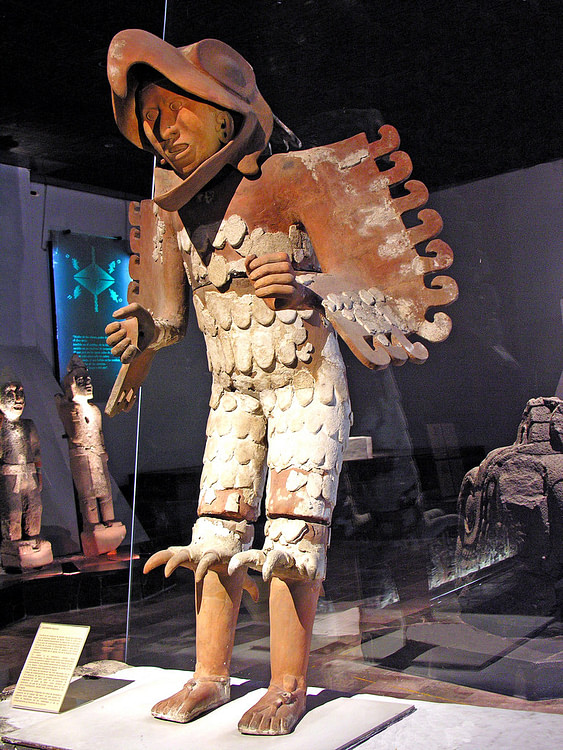
The Aztecs engaged in warfare ( yaoyotl ) to acquire territory, resources, quash rebellions, and to collect sacrificial victims to honour their gods. Warfare was a fundamental part of Aztec culture with all males expected to actively participate and battle, referred to in Nahuatl poetry as 'the song of shields', was regarded as a perpetual religious and political necessity. The Aztecs were so accomplished in combat that they eventually forged an empire which covered 200,000 square kilometres and, at the height of their power, they extracted tribute from 371 city -states across 38 provinces.
WARFARE IN AZTEC MYTHOLOGY
The Aztecs believed that the god of the sun and war Huitzilopochtli had been fully armed and ready for war from the very moment of his birth from his mother Coatlicue. Indeed, the first act of this blood-thirsty war god was to kill without mercy his rebellious sister Coyolxauhqui and his 400 siblings, the Centzonhuitznahuac and Centzonmimizcoa. In mythology, the dismembered bodies of Coyolxauhqui and the 400 became the moon and stars respectively. That warfare was an everyday reality is reflected in the Aztec belief that the conflict between Huitzilopochtli and his siblings re-occurred every day, symbolised by the contest between sun and moon each 24 hours. Further, that war was glorified is evidenced in the belief that fallen warriors accompanied the sun on his daily journey and later returned to earth as hummingbirds. Human sacrifices were regularly made to Huitzilopochtli at his temple atop the great pyramid, the Templo Mayor, at the Aztec capital Tenochtitlan. One of the most important such sacrificial ceremonies was held on the winter solstice, the traditional beginning of the campaign season.
ELITE UNITS COULD ONLY BE JOINED BY WARRIORS WHO HAD DISPLAYED NO FEWER THAN 20 ACTS OF BRAVERY IN BATTLE.
THE AZTEC ARMY
The military commander-in-chief was the king himself, the tlatoani. He was assisted by his second-in-command, who had the title cihuacoatl. Joining these two in a war council were four more of the highest ranking nobles, typically relatives of the king.These four had the titles of tlacochcalcatl, t laccetacatl, tillancalqui, and etzhuanhuanco. Reporting to the council were diverse units of warriors with varying levels of status, although it is important to note that brave and able soldiers could certainly climb through the ranks if they took a specific number of captives. Aztec symbols of rank included the right to wear certain feather headdresses, cloaks, and jewellery - lip, nose, and ear-plugs. Officers also wore large ensigns of reeds and feathers which towered above their shoulders. The most prestigious units were the cuauhchique or 'shaved ones' and the otontin or 'otomies'. These two elite units could only be joined by warriors who had displayed no fewer than 20 acts of bravery in battle and were already members of the prestigious jaguar and eagle warrior groups. Even the lowest ranks could win through valour privileges, such as the right to eat in the royal palaces, have concubines, and drink pulque beer in public.
Warriors were trained from a young age in special military compounds where children learnt to master weapons and tactics and where they were regaled with tales of battle from veteran warriors. Youths also accompanied the Aztec army on campaign, acting as baggage handlers, and when they finally became warriors and took their first captive, they could at last cut off the piochtli hair lock at the back of their necks which they had worn since the age of ten. Boys were now men and ready to fulfil their purpose: to die gloriously in battle and return as hummingbirds.
There is nothing like death in war,nothing like the flowery deathso precious to Him who gives life:far off I see it: my heart yearns for it!Nahuatl song
The Aztecs did not have a permanent or standing army but called up warriors when required. Each town was required to provide a complement of 400 men for campaigns, during which they would remain as a unit led by one of their own senior warriors and march under their own standard but also be a part of a larger group of 8,000 men. As many as 25 such divisions, or 200,000 men, could be mobilized for a large-scale campaign. Besides men, towns also had to provide supplies such as maize, beans, and salt, which would be carried on campaign by the baggage handlers. On the march the army was preceded by scouts, easily recognised by their yellow face-paint and conch-shell trumpets, and priests, who bore images of Huitzilopochtli. The main body of the army, often stretching some 25 kilometres along narrow trails, had the elite units leading from the front. Next came ordinary units from each of the empire's allies, starting with the armies of Tenochtitlan, and finally, the troops acquired from tribute quotas brought up the rear. When necessary, camps were simple affairs with reed mat shelters for the elite and the open-air for ordinary troops.
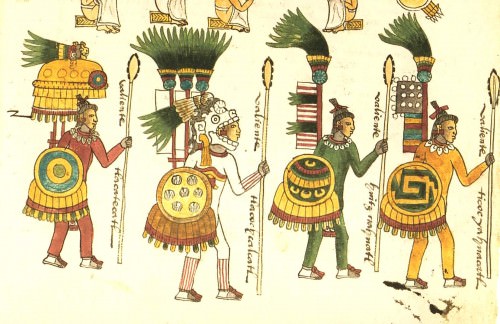
Aztec Warriors
WEAPONS & ARMOUR
Aztec warriors, who were taught from childhood in weapons handling, were expert users of clubs, bows, spears, and darts.Protection from the enemy was provided via round shields ( chimalli ) and, more rarely, helmets. Clubs or swords ( macuahuitl) were studded with fragile but super-sharp obsidian blades. Spears were short and used for jabbing and stabbing the enemy at close quarters. The atlatl was a dart-throwing device made of wood, and using one, an experienced warrior could direct accurate and deadly darts ( mitl ) or javelins ( tlacochtli ) while remaining a safe distance from the enemy or during the first stage of battle when the two armies lined up facing each other. Shields of wood or reeds were made more resistant with leather additions and decorated with heraldic designs such as birds, geometric shapes, and butterflies. Elite warriors could wear leather helmets, elaborately carved with symbols of their rank and unit. Body armour ( ichcahuipilli ) was also worn and made from quilted cotton which was soaked in salt water to make the garment stiffer and more resistant to enemy blows.There was no uniform as such, but ordinary warriors wore a simple tunic over a loincloth and wore war-paints. Elite warriors were much more impressively decked out with exotic feathers and animal skins. The Jaguar warriors wore jaguar skins and helmets with fangs, whilst the eagle warriors were dressed for battle in feathered suits complete with talons and a beaked helmet.
STRATEGIES
Usually campaigns began in order to redress a wrong such as the murder of traders, the refusal to give tribute, or failure to send representatives to important ceremonies at Tenochtitlan. The Aztecs also sought to create a buffer zone between their empire and neighbouring states. These areas were treated slightly better, allowed greater autonomy and were obliged to give less tribute. Yet another reason for war was the Coronation Wars. These were traditional campaigns whereby a new Aztec tlatoani proved his worth following his accession by conquering regions and acquiring tribute and prisoners for sacrifice.
Actual fighting was usually preceded by diplomatic missions where ambassadors ( quauhquauhnochtzin ) reminded of the price of defeat in battle and attempted to persuade a peaceful alternative of reasonable tribute and acceptance of the supremacy of the Aztec gods. Additionally, spies ( quimichtin or 'mice') could be sent into the target area disguised as merchants and dressed in local costume. If, upon the failure of diplomacy, war was still necessary and the defending army was defeated, then the principal city was sacked and the whole region considered conquered.
The battlefield is the place:where one toasts the divine liquor in war,where are stained red the divine eagles,where the jaguars howl,where all kinds of precious stones rain from ornaments,where wave headdresses rich with fine plumes,where princes are smashed to bits.Nahuatl song.
On the battlefield, usually a plain, combat was typically preceded by both armies facing each other with much shouting, posturing, and the beating of drums and blowing of conch-shell trumpets and bone flutes. Leaders positioned troops to best take advantage of local geographical features, and they led from the front and very much by example, throwing themselves into the battle. As the two armies faced off, heavy stones were thrown and followed by a more deadly volley of darts. Then came a bloody hand-to-hand combat, where the obsidian-bladed spears and clubs slashed the enemy creating fearsome wounds. Here all order was lost and battle became a series of independent duels where warriors tried to capture their opponent alive. Indeed, assistants with ropes followed the fighting in order to immediately truss up the vanquished for later sacrifice. Ruse tactics could also be employed, such as pretending to flee the battlefield or hiding in covered trenches in order to ambush enemy troops. Victory conventionally came when the enemy's main temple had been sacked. The discipline and sheer ferocity of the Aztec warriors was usually far superior to that of the enemy and ensured success after success across ancient Mexico.
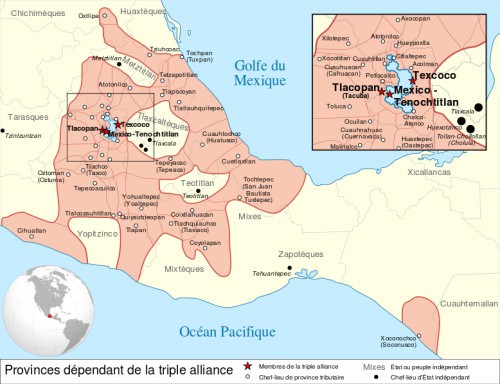
Aztec Empire
THE FLOWERY WARS
Besides the desire for new territory and war-booty, the Aztecs very often specifically went on campaign in order to acquire sacrificial victims. Indeed, both sides agreed to the battle beforehand, agreeing that the losers would provide warriors for sacrifice. The Aztecs believed that the blood of sacrificial victims, especially of brave warriors, fed the god Huitzilopochtli.Taken as captives after battles, the victims had their hearts removed and the corpse was skinned, dismembered and decapitated. These campaigns were known as xochiyaoyotl or a 'flowery war' because the victims were defeated warriors who were trussed up, and with their splendid feather war costumes, looked like flowers as they were unceremoniously transported back to Tenochtitlan. One Aztec general, named Tlacaelel, likened this process to shopping in a market and stated that the victims should be as easy to pick up as tortillas. A favourite hunting ground for these military expeditions was the eastern Tlaxcala state and cities such as Atlixco, Huexotzingo and Cholula. The earliest known example of a xochiyaoyotl was in 1376 CE against the Chalca, a conflict which, perhaps unsurprisingly, developed into a full-scale war. Generally speaking, though, the intention was only to take a sufficient number of victims and not to start all-out hostilities; for this reason many Aztec campaigns were not decisive engagements aimed at territorial control. Nevertheless, the flower wars must have reminded who the rulers were and may also have served as a regular pruning of opposition military power.
THE VICTOR'S SPOILS
First and foremost, successful warfare brought the Aztecs new territory and secured and extended their lucrative trade network. Parcels of land were also distributed to nobles and elite warriors. Defeat did not necessarily mean the end of the vanquished's way of life, for conquered rulers were very often left in power, although sometimes populations were massacred and children relocated and dispersed in other communities. Generally, the real price of defeat was essentially agreements to pay regular tributes in both goods and people to their new masters. Tribute could be in the form of slaves, military service, gold dust, precious jewellery, metals, blankets, clothes, cotton, exotic feathers, shields, cochineal dye, rubber, shells, grain, chillies, chocolate beans (cacao), and salt. Curiously, the Aztecs also took away statues and idols, especially religiously important ones. These 'captives' were symbolically held at Tenochtitlan and illustrated that the new masters controlled not only a people's territory but now also their religion and ideas.
THE AZTEC COLLAPSE
The Aztecs were very successful in conquering neighbouring territories, especially during the reigns of Moctezuma I, Ahuitzotl, and Moctezuma II ( Montezuma ), but they did occasionally suffer defeats. One of the worst of these was against their long-time enemies, the Tarascans, in 1479 CE when an army of 32,000 led by Axayacatl was wiped out in two engagements near Taximaloyan. The Aztecs were also constantly having to put down rebellions, and these conquered peoples were often all too happy to side with the European invaders when they came in 1519 CE. Scholars have also noted that the way Aztec warfare was conducted - pre-battle diplomacy, the absence of surprise attack, and especially the lack of a need to completely destroy the enemy - gave the more direct Spanish conquistadores a distinct advantage when they sought to colonize ancient Mexico. Token victories such as the flower wars were not part of the military vocabulary of the European invaders, and the battle for Mesoamerica was, then, perhaps the Aztecs' first and last experience of total war.
Aztec Sacrifice › Origins
Definition and Origins

The Aztec civilization which flourished in Mesoamerica between 1345 and 1521 CE has gained an infamous reputation for bloodthirsty human sacrifice with lurid tales of the beating heart being ripped from the still-conscious victim, decapitation, skinning and dismemberment. All of these things did happen but it is important to remember that for the Aztecs the act of sacrifice - of which human sacrifice was only a part - was a strictly ritualised process which gave the highest possible honour to the gods and was regarded as a necessity to ensure mankind's continued prosperity.
ORIGINS & PURPOSE
The Aztecs were not the first civilization in Mesoamerica to practise human sacrifice as probably it was the Olmec civilization (1200-300 BCE) which first began such rituals atop their sacred pyramids. Other civilizations such as the Mayaand Toltecs continued the practice. The Aztecs did, however, take sacrifice to an unprecedented scale, although that scale was undoubtedly exaggerated by early chroniclers during the Spanish Conquest, probably to vindicate the Spaniards own brutal treatment of the indigenous peoples. Nevertheless, it is thought that hundreds, perhaps even thousands, of victims were sacrificed each year at the great Aztec religious sites and it cannot be denied that there would also have been a useful secondary effect of intimidation on visiting ambassadors and the populace in general.
In Mesoamerican culture human sacrifices were viewed as a repayment for the sacrifices the gods had themselves made in creating the world and the sun. This idea of repayment was especially true regarding the myth of the reptilian monster Cipactli (or Tlaltecuhtli ). The great gods Quetzalcoatl and Tezcatlipoca ripped the creature into pieces to create the earth and sky and all other things such as mountains, rivers and springs came from her various body parts. To console the spirit of Cipactli the gods promised her human hearts and blood in appeasement. From another point of view sacrifices were a compensation to the gods for the crime which brought about mankind in Aztec mythology. In the story Ehecatl -Quetzalcóatl stole bones from the Underworld and with them made the first humans so that sacrifices were a necessary apology to the gods.
WARFARE WAS OFTEN CONDUCTED FOR THE SOLE PURPOSE OF FURNISHING CANDIDATES FOR SACRIFICE.
Gods then were 'fed' and 'nourished' with the sacrificed blood and flesh which ensured the continued balance and prosperity of Aztec society. In Nahuatl the word for sacrifice is vemana which derives from ventli (offering) and mana 'to spread out' representing the belief that sacrifices helped in the cycle of growth and death in food, life and energy. Accordingly, meat was burnt or blood poured over the statues of deities so that the gods might partake of it directly. Perhaps the quintessential example of 'feeding' the gods were the ceremonies to ensure Tezcatlipoca, the sun god, was well-nourished so that he had the strength to raise the sun each morning.
NON-FATAL SACRIFICE
Blood-letting and self-harm - for example, from the ears and legs using bone or maguey spines - and the burning of blood-soaked paper strips were a common form of sacrifice, as was the burning of tobacco and incense. Other types of sacrifice included the offering of other living creatures such as, deer, butterflies and snakes. In a certain sense offerings were given in sacrifice, precious objects which were willingly handed over for the gods to enjoy. In this category were foodstuffs and objects of precious metals, jade and shells which could be ritually buried. One of the most interesting such offerings was the dough images of gods ( tzoalli ). These were made from ground amaranth mixed with human blood and honey, with the effigy being burnt or eaten after the ritual.
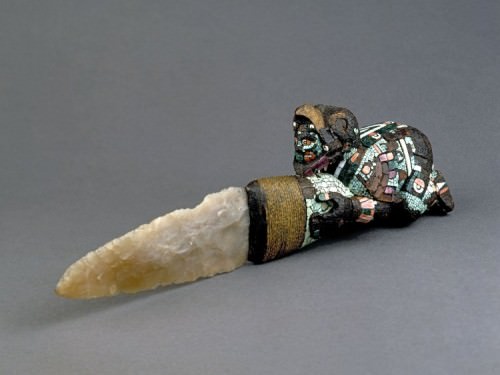
Aztec Ceremonial Knife
SELECTION & PREPARATION OF VICTIMS
With human sacrifices the sacrificial victims were most often selected from captive warriors. Indeed, warfare was often conducted for the sole purpose of furnishing candidates for sacrifice. This was the so-called 'flowery war ' ( xochiyaoyotl ) where indecisive engagements were the result of the Aztecs being satisfied with taking only sufficient captives for sacrifice and where the eastern Tlaxcala state was a favourite hunting-ground. Those who had fought the most bravely or were the most handsome were considered the best candidates for sacrifice and more likely to please the gods. Indeed, human sacrifice was particularly reserved for those victims most worthy and was considered a high honour, a direct communion with a god.
Another source of sacrificial victims was the ritual ball-games where the losing captain or even the entire team paid the ultimate price for defeat. Children too could be sacrificed, in particular, to honour the rain god Tlaloc in ceremonies held on sacred mountains. It was believed that the very tears of the child victims would propitiate rain. Slaves were another social group from which sacrificial victims were chosen, they could accompany their ruler in death or be given in offering by tradesmen to ensure prosperity in business.
Amongst the most honoured sacrificial victims were the god impersonators. Specially chosen individuals were dressed as a particular god before the sacrifice. In the case of the Tezcatlipoca impersonator in the ritual during Tóxcatl (the 6th or 5th month of the Aztec solar year) the victim was treated like royalty for one year prior to the sacrificial ceremony. Tutored by priests, given a female entourage and honoured with dances and flowers, the victim was the god's manifestation on earth until that final brutal moment when he met his maker. Perhaps even worse off was the impersonator of Xipe Totec who, at the climax of the festival of Tlacaxipehualiztli, was skinned to honour the god who was himself known as the 'Flayed One'.
Amongst the most honoured sacrificial victims were the god impersonators. Specially chosen individuals were dressed as a particular god before the sacrifice. In the case of the Tezcatlipoca impersonator in the ritual during Tóxcatl (the 6th or 5th month of the Aztec solar year) the victim was treated like royalty for one year prior to the sacrificial ceremony. Tutored by priests, given a female entourage and honoured with dances and flowers, the victim was the god's manifestation on earth until that final brutal moment when he met his maker. Perhaps even worse off was the impersonator of Xipe Totec who, at the climax of the festival of Tlacaxipehualiztli, was skinned to honour the god who was himself known as the 'Flayed One'.

Temple Mayor, Tenochtitlan
CEREMONIES & DEATH
Conducted at specially dedicated temples on the top of large pyramids such as at Tenochtitlan, Texcoco and Tlacopan, sacrifices were most often carried out by stretching the victim over a special stone, cutting open the chest and removing the heart using an obsidian or flint knife. The heart was then placed in a stone vessel ( cuauhxicalli ) or in a chacmool (a stone figure carved with a recipient on their midriff) and burnt in offering to the god being sacrificed to. Alternatively, the victim could be decapitated and or dismembered. MDCoe suggests that this method was typically reserved for female victims who impersonated gods such as Chalchiuhtlicue but images recorded by the Spanish in various Codex do show decapitated bodies being flung down the steps of pyramids. Those sacrificed to Xipe Totec were also skinned, most probably in imitation of seeds shedding their husks.
Victims could also be sacrificed in a more elaborate process where a single victim was made to fight a gladiatorial contest against a squad of hand-picked warriors. Naturally, the victim had no possibility to survive this ordeal or even inflict any injury on his opponents as not only was he tied to a stone platform ( temalacatl ) but his weapon was usually a feathered club while his opponents had vicious razor-sharp obsidian swords ( macuauhuitl ). In another method, victims could be tied to a frame and shot with arrows or darts and in perhaps the worst method of all, the victim was repeatedly thrown into a fire and then had his heart removed.
After the sacrifice, the heads of victims could be displayed in racks ( tzompantli ), depictions of which survive in stone architectural decoration, notably at Tenochtitlán. The flesh of those sacrificed was also, on occasion, eaten by the priests conducting the sacrifice and by members of the ruling elite or warriors who had themselves captured the victims.
Weapons in Ancient Egypt › Origins
Ancient Civilizations
The ancient Egyptian military is often imagined in modern films and other media as a heavily armed and disciplined fighting force equipped with powerful weapons. This depiction, however, is only true of the Egyptian army of the New Kingdom (c. 1570-1069 BCE) and, to a lesser extent, the army of the Middle Kingdom (2040-1782 BCE), when the first professional armed force was created by Amenemhat I (c. 1991-1962 BCE). Prior to this time, the army was made up of conscripts from different districts ( nomes ) who were enlisted by their respective governors ( nomarchs ). Although this early army was certainly effective enough for its purpose, it was not a group of professional soldiers equipped with the most effective weaponry. Egyptologist Helen Strudwick notes:
Soldiers of the Old and Middle Kingdoms were fairly inadequately equipped. The only development in weapons since Predynastic times had been the replacement of flint blades with those of copper. (464)
Weaponry in ancient Egypt developed in response to its necessity. The early bows, knives, and axes of the Predynastic Period in Egypt (c. 6000-c.3150 BCE) through the Old Kingdom (c. 2613-2181 BCE) were sufficient in putting down local rebellions or conquering neighbors on the border, who were similarly armed but were not the most efficient. As Egypt expanded its influence throughout neighboring regions and came into conflict with other nations, they needed to make a number of adjustments; one of these was in weaponry.
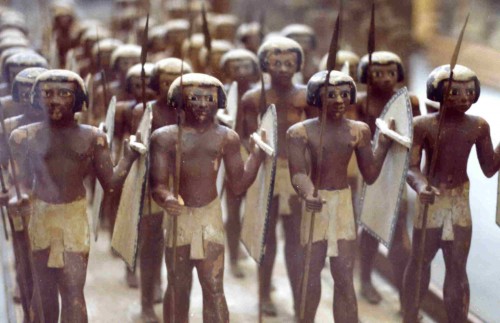
Egyptian Warriors
EARLY EGYPTIAN WEAPONS
In the Early Dynastic Period in Egypt (c. 3150-c.2613 BCE), military weaponry was comprised of maces, daggers, and spears. The spear had been developed by hunters during the Predynastic Period and changed very little except, like daggers, the tip changed from flint to copper. Even so, the majority of spear- and arrowheads from the Old Kingdom of Egypt seem to have been largely flint. An Egyptian soldier would have carried a spear and dagger, and a shield probably made of animal hide or woven papyrus.
These weapons were supplemented during the Old Kingdom by archers who used a simple single-arched bow with reed arrows and flint or copper tips. These bows were difficult to draw, were only effective at close range and, even then, were not very accurate. The archers, like the rest of the army, were drawn from the lower-class peasantry and would have had little experience with a bow in hunting. Egyptologist Margaret Bunson describes the Old Kingdom army:
The soldiers of the Old Kingdom were depicted as wearing skull caps and carrying clan or nome-totems. They used maces with wooden heads or pear-shaped stone heads. Bows and arrows were standard gear, with square-tipped flint arrowheads and leather quivers. Some shields, made of hides, were in use but not generally.Most of the troops were barefoot, dressed in simple kilts, or naked. (168)

Reed Arrow Shafts
Weapons, and the military in general, did not begin to develop significantly until the Middle Kingdom of Egypt. When the central government of the Old Kingdom collapsed, it initiated the era known as the First Intermediate Period of Egypt (c. 2181- 2040 BCE) in which the individual nomarchs had more power than the king. These nomarchs would still send conscripts to the government when called upon but were free to exercise their own power and extend it beyond their districts if they wished.
This is precisely what did happen when Mentuhotep II of Thebes (c. 2061-2010 BCE) elevated his city from just another nomein Egypt to the capital of the country. Mentuhotep II defeated the ruling party at Herakleopolis c. 2040 BCE and united the country under Theban rule.
THE MIDDLE KINGDOM ARMY
Mentuhotep II initiated the Middle Kingdom through military might, but it was Amenemhat I who organized the first professional fighting force. As in earlier eras, these soldiers were equipped with weapons sufficient for their purpose but were still far from what they would eventually become. Strudwick describes the Middle Kingdom forces:
The heavy infantry carried wood and leather shields, copper-headed spears and swords. The light infantry were armed with bows and primitive arrows made from a bronze alloy and reed shafts. Troops had neither protective helmets nor armour. (464)
Archers in this period still used the same single-arched bow and the same type of arrows, carried in a long quiver slung over the back by a strap. Daggers were copper blades riveted to handles and the sword was simply a long dagger. Since the blades were riveted to the handles, instead of the weapon being cast as a single piece, they were not as strong. One powerful blow from an opponent could snap a sword's blade from its handle.
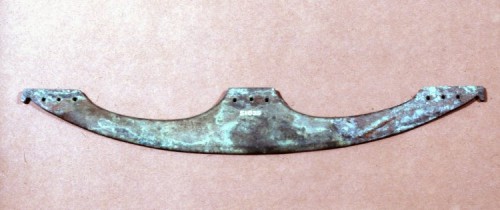
Middle Kingdom Axe-head
Other weapons used at this time were the slicing axe and the spear. The slicing axe was a long wooden shaft with a crescent copper blade fitted into a notch at one end. The weapon would be wielded with two hands in a swinging motion, almost like a scythe, moving from side to side. A Middle Kingdom sword would have proved fairly ineffective against this weapon.
Although it does not seem the soldiers wore armor at this time, they did have protective gear in the form of leather shirts and kilts. These would not have afforded much protection against a volley of arrows or the slicing axe but were probably better than nothing. A typical soldier in the field would have been equipped with a sword, shield, and spear, and probably a dagger for close fighting. Archers would have naturally carried their bow and arrows and probably a dagger.
This was the army of Senusret III (c. 1878-1860 BCE), considered the greatest king of the era and the most powerful warrior.Senusret III became the basis for the later legends of the great king Sesostris who, according to the Greek writer Diodorus Siculus, conquered the known world of his time. Senusret III, of course, did no such thing, but he did expand Egyptian territory through numerous military campaigns and ruled so effectively that his reign is largely responsible for the Middle Kingdom's enduring reputation as a 'golden age.' Even so, all of these weapons and the army itself would soon change dramatically through an event the Egyptians of the Middle Kingdom could not ever have conceived of.
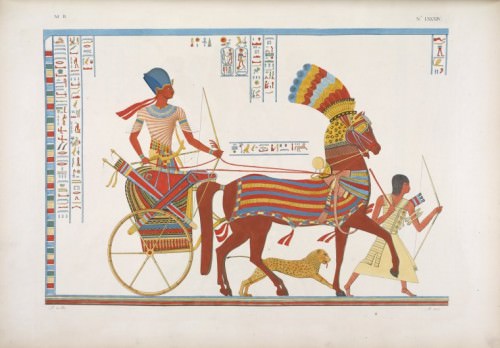
Egyptian War Chariot
THE HYKSOS & EGYPTIAN WEAPONRY
The Middle Kingdom is considered the 'classical age' of Egyptian culture and history, but toward the end, the central government became weak and distracted by its own difficulties. A people known as the Hyksos, who had probably been trading with Egypt for some time, were allowed to gain a permanent foothold in Lower Egypt at the city of Avaris and soon were powerful enough to enforce their will through political and military measures.
PRIOR TO THE ARRIVAL OF THE HYKSOS, THE EGYPTIANS HAD NO KNOWLEDGE OF THE HORSE OR HORSE-DRAWN CHARIOT, THEY WERE STILL USING THE SINGLE-ARCHED BOW & WERE EQUIPPED WITH SWORDS WHICH WERE NOT ALWAYS RELIABLE IN PITCHED BATTLE.
Egypt had never experienced anything like the Hyksos before, and later writers would routinely refer to this time (known as the Second Intermediate Period of Egypt, c. 1782-1570 BCE) as the 'Hyksos Invasion,' a term which is still used today. There never was an invasion of the Hyksos, however, and claims to the contrary consistently focus on propaganda from the New Kingdom of Egypt or Manetho's wildly exaggerated version of events as cited in Josephus. While there was certainly armed conflict between the Hyksos and the Egyptians, there is no archaeological evidence and no solid textual evidence for the level of destruction and slaughter the New Kingdom scribes regularly ascribe to the Hyksos.
There is ample evidence, however, that the Hyksos improved Egyptian culture in a number of significant ways and, notably, through weaponry. Prior to the arrival of the Hyksos, the Egyptians had no knowledge of the horse or horse-drawn chariot, they were still using the single-arched bow and were equipped with swords which were not always reliable in pitched battle.Egyptologist Barbara Watterson describes the contributions of the Hyksos to Egyptian weaponry:
The Hyksos, being from western Asia, brought the Egyptians into contact with the peoples and the culture of that region as never before and introduced them to the horse-drawn war chariot; to a composite bow made from wood reinforced with strips of sinew and horn, a more elastic weapon with a greater range than their own simple bow; to a scimitar-shaped sword, called the Khopesh, and to a bronze dagger with a narrow blade cast in one piece with the tang. The Egyptians developed this weapon into a short sword. (60)
The Khopesh (also given as Khepesh) sword was cast entirely of bronze and the handle then wound with hide and cloth and, with more expensive blades, ornamented. This curved sword was much more effective than any the Egyptians had used in the past. The war chariot, manned by archers with the new composite bow and a large quiver attached to the side, would prove one of Egypt's most significant military assets, and the battle axe, made of bronze attached to a haft, was far more effective than the flint or copper axes bound to wooden shafts in the past. The slicing axe is probably the only weapon which Hyksos technology could not improve upon.

Egyptian Bronze Sword
THE NEW KINGDOM ARMY
The Hyksos did far more than simply provide the Egyptians with better weapons; they gave them a reason to use them. Egypt had never been governed by a foreign power before, but during the Second Intermediate Period, the Hyksos held the ports of Lower Egypt and a significant amount of territory in the region while the Nubians had been able to expand into Upper Egypt and establish fortifications there. Only Thebes in Upper Egypt, between these two foreign powers, was ruled by Egyptians until Ahmose I of Thebes (c. 1570-1544 BCE) drove the Hyksos from the country, defeated the Nubians, and unified Egypt under his rule, initiating the New Kingdom.
Interestingly, excavations at the site of Avaris have uncovered weapons of both the Hyksos and the Egyptian forces from the assault of Ahmose I. These finds show that the Hyksos' blades had become inferior not only to the Egyptians' but to their own earlier work. It seems that, by this time, the Hyksos were making weapons largely for ceremonial, rather than practical, use.Egyptologist Janine Borriau notes:
Battle axes and daggers from stratum D/3 were of unalloyed copper, whereas weapons from earlier strata were made of tin bronze, which produced a weapon with a far superior cutting edge...In contrast, weapons of the same period from Upper Egypt were made of tin bronze and this would have given the Thebans a clear advantage in hand-to-hand fighting. (Shaw, 202)
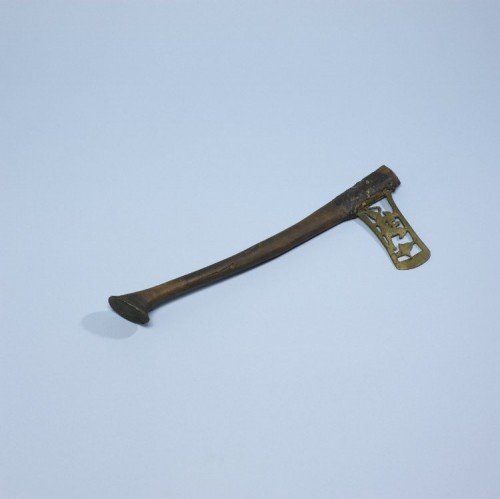
Ornamental Axe
Ahmose I used these weapons effectively against both the Hyksos and the Nubians to secure Egypt and then embarked on a campaign of conquest which his successors would continue. The monarchs of the New Kingdom were determined that never again would a foreign nation gain such power in Egypt and so expanded the country's borders to provide a buffer zone which then grew into the Egyptian Empire. The campaigns of Ahmose I through those of Thutmose III (1458-1425 BCE) steadily expanded Egypt's territory, which then grew further under later pharaohs. As the army encountered new adversaries, they learned from them as Strudwick explains:
By the New Kingdom, the Egyptian army had begun to adopt the superior weapons and equipment of their enemies - the Syrians and Hittites. The triangular bow, the helmet, chain-mail tunics, and the Khepesh sword became standard issue. Equally, the quality of the bronze improved as the Egyptians experimented with different proportions of tin and copper. (466)
The weapons of the Egyptian army were now quite different from those of the Old Kingdom and so was the military itself.Bunson writes:
The army was no longer a confederation of nome levies but a first-class military force...organized into divisions, both chariot forces and infantry. Each division numbered approximately 5,000 men. These divisions carried the names of the principal deities of the nation. (170)
Unlike the early army which went to battle under the banners of their nomes and clans, the New Kingdom army fought for the welfare of the entire country, bearing the standards of the universal gods of Egypt. The king was the commander-in-chief of the armed forces with his vizier and subordinates handling the logistics and supply lines. The chariot divisions, in which the pharaoh rode, were directly under his command and divided into squadrons with their own captain. There were also mercenary forces, like the Medjay, who served as shock troops.
IRON WEAPONS & DECLINE
Shields in the early New Kingdom were made of wood covered with animal hide, and the swords continued to be of tin bronze until after the Battle of Kadesh in 1274 BCE between the Egyptians under Ramesses II (1279-1213 BCE) and Muwatalli II (1295-1272 BCE) of the Hittites. This engagement was the campaign Ramesses II was most proud of and the victory he had announced through inscriptions, monuments, and the famous Poem of Pentaur and The Bulletin which narrate the triumph.Modern scholars have concluded that the battle was more of a draw than a victory for either side, but both the Egyptians and their Hittite adversaries claim to have won the day.
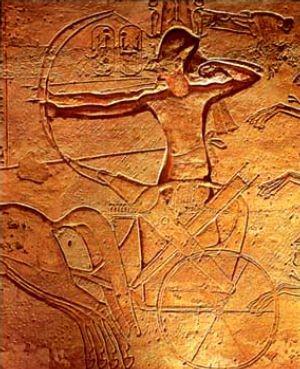
Ramesses II at The Battle of Kadesh
The Battle of Kadesh resulted in the world's first peace treaty in 1258 BCE between Ramesses II and Hattusili III, the successor of Muwatalli II. Egyptologist Jacobus Van Dijk explains the new relationship which was then formed between the two powers:
As a result of the peace treaty with the Hittites, specialist craftsmen sent by Egypt's former enemy were employed in the armoury workshops of Pieramesse to teach the Egyptians their latest weapons technology, including the manufacture of the much sought-after Hittite shields. (Shaw, 292)
These shields, like the Hittite swords and armor, were made of iron, and the city of Per-Ramesses became an important industrial center for the manufacture of arms as Egyptologist Toby Wilkinson describes:
State-of-the-art high-temperature furnaces were heated by blast pipes worked by bellows. As the molten metal came out, sweating laborers poured it into molds for shields and swords. In dirty, hot, and dangerous conditions, the pharaoh's people made the weapons for pharaoh's army. (313-314)
These iron weapons could not be made in great quantity, however. Forging iron required charcoal from burnt lumber, and Egypt had few trees. Egypt entered the so-called Iron Age II in c. 1000 BCE but still could not generate the number of iron weapons they needed to equip the whole army. Ramesses II's successor, Merenptah (1213-1203 BCE) would defeat the combined forces of the Libyans and Sea Peoples using the tin bronze sword as would Ramesses III (1186-1155 BCE) in the final battle between the Sea Peoples and Egypt.
Ramesses III is the last effective monarch of the New Kingdom. Although the Egyptian military had iron weapons by c. 1000 BCE, grand war chariots, and a professionally trained force, the army was only as effective as those who commanded. As the New Kingdom declined, the army followed suit, and even though there were brilliant monarchs who ruled in both the Third Intermediate Period and the Late Period of Ancient Egypt, they no longer, for the most part, had the resources or skill to effectively deploy the army in the field.
LICENSE
Article based on information obtained from these sources:with permission from the Website Ancient History Encyclopedia
Content is available under License Creative Commons: Attribution-NonCommercial-ShareAlike 3.0 Unported. CC-BY-NC-SA License